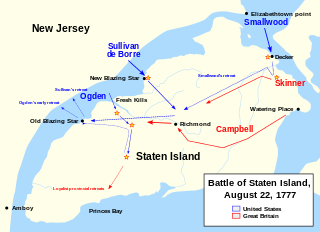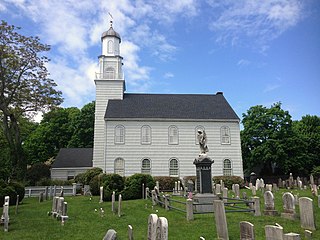
Sag Harbor is an incorporated village in Suffolk County, New York, United States, in the towns of Southampton and East Hampton on eastern Long Island. The village developed as a working port on Gardiners Bay. The population was 2,772 at the 2020 census.

Timeline of the American Revolution—timeline of the political upheaval culminating in the 18th century in which Thirteen Colonies in North America joined together for independence from the British Empire, and after victory in the Revolutionary War combined to form the United States of America. The American Revolution includes political, social, and military aspects. The revolutionary era is generally considered to have begun with the passage of the Stamp Act in 1765 and ended with the ratification of the United States Bill of Rights in 1791. The military phase of the revolution, the American Revolutionary War, lasted from 1775 to 1783.

A whaleboat is a type of open boat that was used for catching whales, or a boat of similar design that retained the name when used for a different purpose. Some whaleboats were used from whaling ships. Other whaleboats would operate from the shore. Later whaleboats usually could operate under sail or oar - American whaling crews in particular obtained better results by making their first approach to a whale under sail, then quickly unstepping the mast and using oars thereafter.

The Battle of Groton Heights was a battle of the American Revolutionary War fought on September 6, 1781 between a small Connecticut militia force led by Lieutenant Colonel William Ledyard and the more numerous British forces led by Brigadier General Benedict Arnold and Lieutenant Colonel Edmund Eyre.

The Mount Hope Bay raids were a series of military raids conducted by British troops during the American Revolutionary War against communities on the shores of Mount Hope Bay on May 25 and 31, 1778. The towns of Bristol and Warren, Rhode Island were significantly damaged, and Freetown, Massachusetts was also attacked, although its militia resisted British attacks more successfully. The British destroyed military defenses in the area, including supplies that had been cached by the Continental Army in anticipation of an assault on British-occupied Newport, Rhode Island. Homes as well as municipal and religious buildings were also destroyed in the raids.

Return Jonathan Meigs was a colonel in the Continental Army during the American Revolutionary War, and an early settler of the Northwest Territory. He also served as an Indian agent working with the Cherokee in East Tennessee.

Samuel Holden Parsons was an American lawyer, jurist, general in the Continental Army during the American Revolutionary War, and a pioneer to the Ohio Country. Parsons was described as "Soldier, scholar, judge, one of the strongest arms on which Washington leaned, who first suggested the Continental Congress, from the story of whose life could almost be written the history of the Northern War" by Senator George F. Hoar of Massachusetts
The 6th Connecticut Regiment was raised on May 1, 1775, at New Haven, Connecticut, as a provincial regiment for the Continental Army. It then became a regiment of the Continental Line on January 1, 1776, designated the 10th Continental Regiment, and a regiment of the Connecticut Line on January 1, 1777, again designated the 6th Connecticut. The regiment saw action at the siege of Boston, the Battle of Long Island, the New York Campaign, and its colonel and company of light infantry served in the Corps of Light Infantry at the Battle of Stony Point. The regiment was merged into the 1st Connecticut Regiment on January 1, 1783, at West Point, New York, and disbanded on November 16, 1783.

The 9th Connecticut Regiment was a regiment of the Continental Army during the American Revolutionary War. It was first called Webb's Additional Continental Regiment before being added to the Connecticut Line in 1780. It saw action at Setauket in 1777, Rhode Island in 1778, and Springfield, New Jersey, in 1780, and was generally active in the defense of Connecticut, southern New York, and northern New Jersey. It was merged into the reorganized 2nd Connecticut Regiment in January 1781.
The 2nd Continental Light Dragoons, also known as Sheldon's Horse after Colonel Elisha Sheldon, was commissioned by the Continental Congress on 12 December 1776, and was first mustered at Wethersfield, Connecticut, in March 1777 for service with the Continental Army. The regiment consisted of four troops from Connecticut, one troop each largely from Massachusetts and New Jersey, and two companies of light infantry.

The northern theater of the American Revolutionary War after Saratoga consisted of a series of battles between American revolutionaries and British forces, from 1778 to 1782 during the American Revolutionary War. It is characterized by two primary areas of activity. The first set of activities was based around the British base of operations in New York City, where each side made probes and counterprobes against the other's positions that sometimes resulted in notable actions. The second was essentially a frontier war in Upstate New York and rural northern Pennsylvania that was largely fought by state militia companies and some Indian allies on the American side, and Loyalist companies supported by Indians, British Indian agents, and occasionally British regulars. The notable exception to significant Continental Army participation on the frontier was the 1779 Sullivan Expedition, in which General John Sullivan led an army expedition that drove the Iroquois out of New York. The warfare amongst the splinters of the Iroquois Six Nations were particularly brutal, turning much of the Indian population into refugees.
Gold Selleck Silliman (1732–1790) was a Connecticut militia General during the American War for Independence.
David Hawley (1741–1807) was a captain in the Continental Navy and a privateer during the American Revolutionary War. He commanded Royal Savage in the 1776 Battle of Valcour Island, which is generally regarded as one of the first naval battles of the American Revolutionary War, and one of the first fought by the United States Navy.

The Battle of Staten Island was a failed raid by Continental Army troops under Major General John Sullivan against British forces on Staten Island on August 22, 1777, during the American Revolutionary War. After British Lieutenant General William Howe sailed with most of his army from New York City in July, Sullivan recognized that the British position on Staten Island was vulnerable, and planned an attack. He carried it out in spite of commanding general George Washington's request that Sullivan reinforce the main army with his troops as soon as possible to support Washington's planned Colonial assault on British-held Philadelphia.
The Battle of Ridgefield was a series of American Revolutionary War skirmishes in Danbury, Connecticut and Ridgefield, Connecticut.

The Battle of Fort St. George was the culmination of a Continental Army raiding expedition led by Benjamin Tallmadge against a fortified Loyalist outpost and storage depot at the Manor St. George on the south coast of Long Island on November 23, 1780, during the American Revolutionary War. Tallmadge's raid was successful; the garrison was surprised, and many provisions and prisoners were taken.

The Battle of Setauket was a failed attack during the American Revolutionary War on a fortified Loyalist outpost in Setauket, Long Island, New York, by a force of Continental Army troops from Connecticut under the command of Brigadier General Samuel Holden Parsons.

The Burning of Fairfield refers to the action of the American Revolutionary War at Fairfield, Connecticut on July 7, 1779 after a British landing force under the command of General William Tryon attacked the town, engaged and dispersed its militia forces, and burned down the vast majority of its buildings. Much of the action took place in areas that are now part of Bridgeport, Southport, and Westport.
The Whaleboat War was a series of actions fought by American privateers in the aftermath of the British victory Battle of Long Island and in the context of the subsequent Northern theater of the American Revolutionary War after Saratoga. The Americans used whaleboats rowed from the New Jersey into New York Bay and from Connecticut into Long Island Sound to capture and disrupt British commercial shipping, occasionally making raids on the coast of British occupied Long Island. They quickly sold their prizes, dividing their profits with the financier and the state.
















